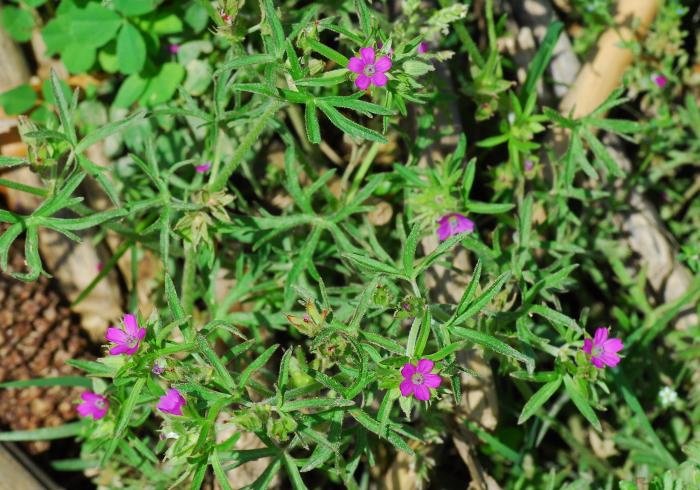Geranium dissectum L.
Cutleaf Crane's Bill

Introduced
CC = *
CW = 5
MOC = 8
© SRTurner
Geranium dissectum L.Cutleaf Crane's Bill | |
 |
Introduced CC = * CW = 5 MOC = 8 |
© SRTurner |
|
Family - Geraniaceae Habit - Taprooted annual forb. Stems - From a taproot, single or typically multiple from the base, erect to ascending, densely pubescent (the hairs spreading to retrorse), stout, to 50cm tall (long), branching, herbaceous.
Leaves - Alternate, petiolate, stipulate. Stipules acuminate, typically reddish, to +1.5cm long, 3-5mm broad, subulate, greatly reduced upward. Petioles to +/-15cm long, densely pubescent, mostly terete. Blades palmately 5-lobed, as long as broad, 5-7cm broad, pubescent. Veins impressed above, expressed below. Main lobes of the leaves divided again. Ultimate divisions often with a minute reddish tip, linear, 1-3mm broad in the upper leaves, broader on the lowest leaves. Apices of the ultimate divisions of the lowest leaves often rounded to subacute, those of the upper leaves acute.
Inflorescence - Paired axillary flowers. Peduncles to 1-2cm long (in fruit), pubescent as the stem. Pedicels to 1-2cm long (in fruit), erect, glandular pubescent, subtended by ciliate bracts. Bracts subulate, to 5mm long, 1-2mm broad.
Flowers - Petals 5, deep pink to purplish, distinct, emarginate, 3-4mm long, 2mm broad, mostly glabrous but with some glandular pubescence externally and with small tufts of hairs at the base. Stamens 10, erect. Filaments compressed and expanded at the base, ciliate, pink apically, to 2mm long. Anthers purplish-yellow, .7mm broad. Styles 5, deep pink apically (for about 1mm), simple and glandular pubescent. Ovary superior, 5-carpellate, simple and glandular pubescent. Sepals 5, erect, pubescent internally, ciliate-margined, glandular and simple pubescent externally, accrescent, 3mm long in flower, to 8mm long in fruit, 3mm broad, with a 1-2mm long mucro. Carpels becoming black in fruit, to 3mm long, pubescent with short spreading hairs, one-seeded. Expanded style tube to -2cm long in fruit, densely glandular pubescent.
Flowering - April - August. Habitat - Lawns, grassy open ground, roadsides. Origin - Native to Europe. Lookalikes - G. carolinianum, G. pusillum. Other info. - This weedy yet showy species is uncommon in Missouri but its range will probably continue to expand with time. Like other of the small, weedy members of the genus, the plant is probably spread by mowing equipment, and can often be found near trailheads and parking lots which are maintained by city or county mowing equipment. This species resembles another, G. carolinianum L., but the latter has much paler pink to flowers and fruits with only nonglandular pubescence. Photographs taken off Hwy 29 near Greensboro, NC., 4-20-03 (DETenaglia); also at Klondike County Park, St. Charles County, MO, 5-6-2013, near Dutzow, Warren County, MO, 5-12-2017, in Washington, MO, 4-29-2018, and at Blue River fishing and hunting reserve, Johnston County, OK, 5-25-2023 (SRTurner). |